**Please note the below is just my opinion based on job experiences**
Intro
Below I have included my experience with cement encaustic tiles after dozens of restoration jobs with these tiles. I will include cleaning and restoration tips below and I will also describe a professional sealing process for your cement encaustic tiles.
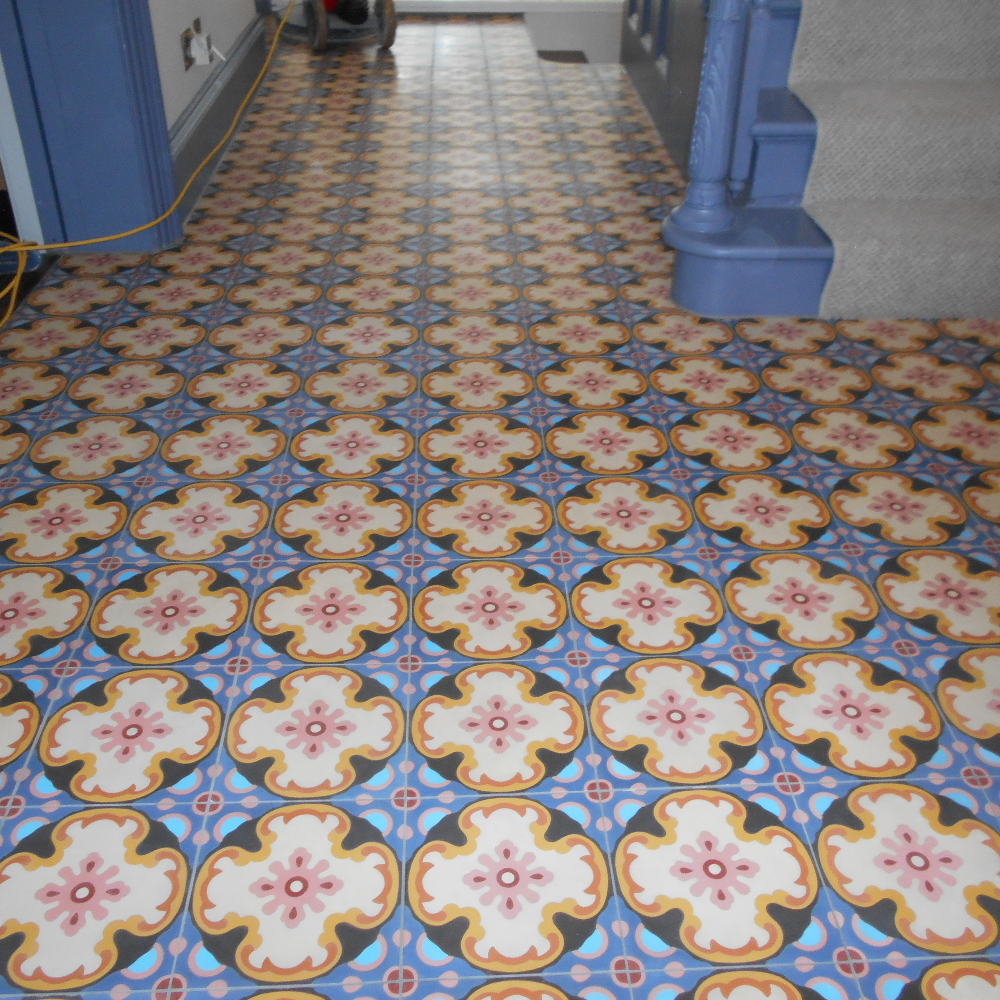

What are encaustic cement tiles & how are they made (briefly)?
Cement encaustic tiles are made from a mixture of mineral powders, pigments, sand and cement. The mixtures of different colours are then poured into segments of a mold ( see pic below). Once all ready the tiles get pressed in a hydraulic clamp that compacts the material. They are not fired in a kiln and have no glaze on the surface. The colours in the tile run all the way through.
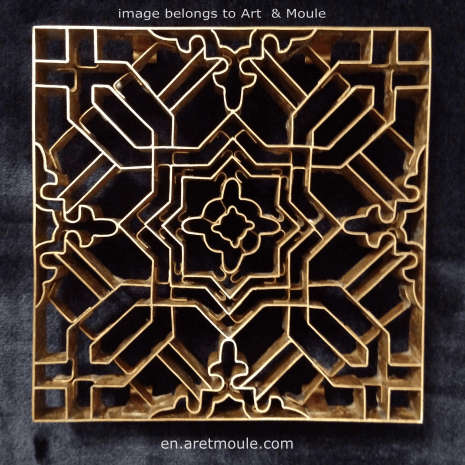

Are cement encaustic tiles durable?
ABSOLUTELY NOT! After seeing cement encaustic tiles performance over a period of years in high traffic areas and even low traffic areas. They are usually rife with staining , etching , pigment bleaching and can look absolutely terrible in bathroom and shower rooms. I have had clients report staining and marks after just three months after installation. There is allot of media on the net describing these tiles as durable , this simply is not the case in my opinion. They are also incredibly porous which makes it very easy for any harmfully liquid to go deep into the tile very quickly.
What products and cleaning detergents damages cement encaustic tiles?
It seams the pigments in the mix that make up the colours are incredibly sensitive to anything remotely acidic and any form of oxidising agent. This includes phosphoric citrus based acid cleaners that would remove limescale such as Viakal or things like regular Bleach. However I have seen encaustic tiles in bathrooms that have been damaged by regular soaps and bathroom products as well. The dark cement tiles in the pic below where damaged by a combination of bathroom soaps and products and some bleach according to the homeowner.
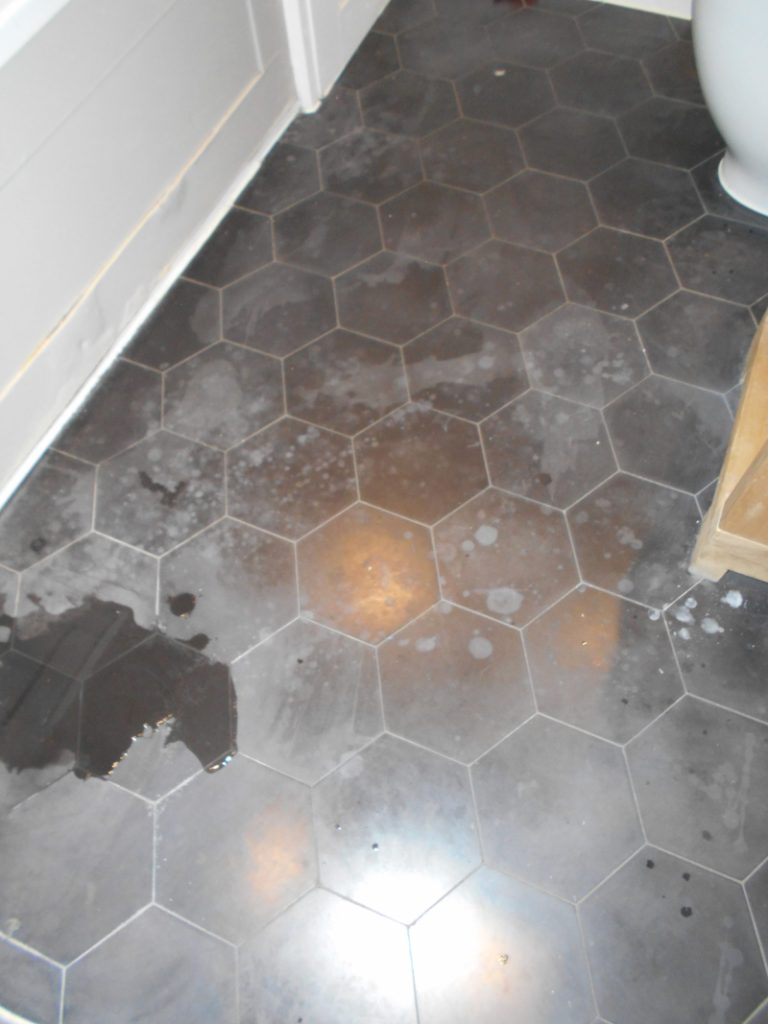

The dark green tiles in the pic below where damaged solely by bathroom shower products such as soap, shower gel etc. There is also some limescale build up that has taken root deep into the surface of the tile.
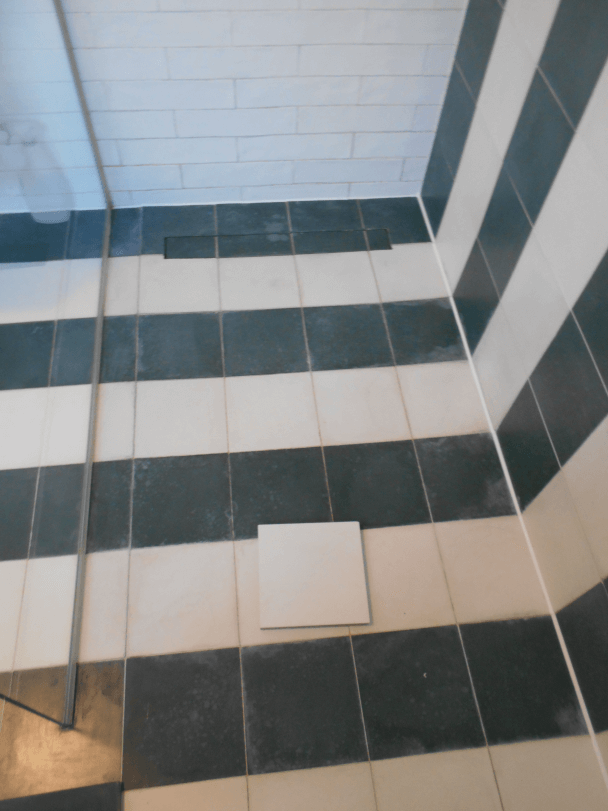

Limescale effect on Cement encaustic tiles and how to remedy it ( as best as it can be)
Limescale ( some present in pic above) I have found really effects the darker colours in the patterns for cement tiles. These tiles are incredibly porous and so the hard water finds it way in allowing limescale to form white patches that sit below the surface. This is a real problem as we cant use any acidic products to remove the limescale without causing further damage.
So how do we remove limescale build up in cement encaustic tiles?
The only real way to remove limescale from cement tiles is to try use abrasive paper to mechanically remove it. Abrasive stone resurfacing carbon fibre sand paper available from Stone masonry tool suppliers will aid you in removing the worst of the limescale build up. The worst limescale build up seems to be higher up closer to the surface and on the surface. Then as the limescale runs deeper you will struggle to remove it all with the sand paper. At this stage you can use a colour enhancing oil based sealer to darken the colours. Colour enhancing tile sealers do a great job at masking lighter patches by darkening them to blend them into the darker colours in the patterns.
How to clean cement encaustic tiles guide
Cleaning cement tiles will require a bit of caution and you should test any detergent you want to use in an inconspicuous area.
There are two detergents in the pic below. One is degreasing high alkaline. And the other is PH neutral and much more gentle.
High alkaline degreasing detergents to clean cement encaustic tiles
Start the cleaning with a high alkaline degreasing type cleaner. Do a small test first and when dry see if the colour has changed at all. If it has then you will need to use a the gentler PH neutral detergent. If the high alkaline ( PS87 in pic below) detergent works without changing the colour then you will be able to clean them better as its much more effective at removing dirt.
I have found on some jobs that the High alkaline cleaners disturbs the pigments bleaching out the colour. However this is not always the case and sometimes the pigments are fine so check if the degreasing detergent works first! FILA PS87 will also remove old tile sealer within the tiles that may have become discoloured. So you can think of this type of detergent as a washing up liquid. It dissolves grease and grime with ease but this also effects tile sealers and possibly the pigments used to make up the colours in cement encaustic tiles.
PH neutral gentle cleaner for cement encaustic tiles
However in the event that the pigments are disturbed by the degreasing detergent then a PH neutral detergent will need to be used. The FILA product in the pic below is very good! A PH neutral detergent mostly removes surface dirt and wont effect anything else such as the pigments in the tiles and it also wont effect old or new tile sealers that are applied to the encaustic tiles. This is why when we fully clean and seal cement encaustic tiles we maintain them with PH neutral detergents that wont harm the tile sealer.
So ideally you want to be cleaning them with a degreasing detergent but if its going to damage them you are left with a less effective PH neutral detergent to clean the cement tiles.
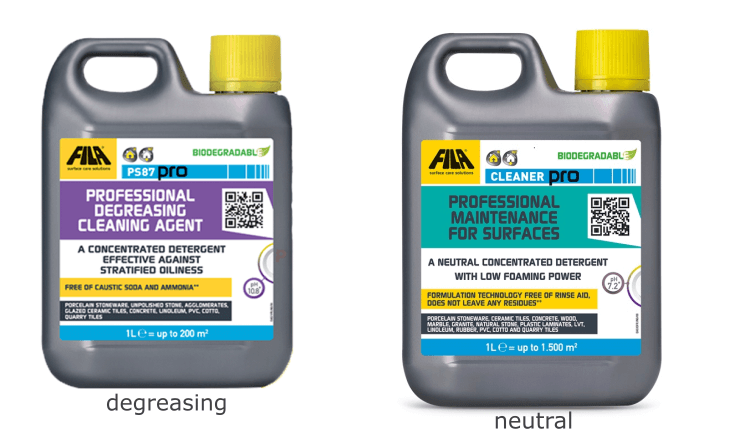

Process of cleaning cement encaustic tiles
I find on jobs that after testing it becomes apparent that some methods work better than others depending on what type of contamination or damage is present withing the tiles. However as a homeowner you will be better of using a hand detailed approach cleaning and scrubbing tile by tile.
Items you will need include..
- hand detailed scrubbing brush
- spray bottle
- micro fibre cloth
- two clean buckets
- your detergents.
Step 1) After testing ( as detailed above) apply the appropriate detergent to a patch about 2-3 square feet. Detergent needs to be allowed to work so it must be on any one tile for at least 5 mins. Also be sure to have mixed the detergent with water as per instructions on the bottle or add water separately to keep a nice wet slurry. Nothing will clean if it becomes dry.
step2) agitate with your scrubbing brush going tile by tile and working the detergent into all the little crevices.
step3) wipe clean with your cloth and rinse all the dirty water into one of the buckets. Keep one bucket filled with clean water and dont put the dirty cloth back into it.
step 4) always rinse the floor by wiping the whole thing over once you have cleaned it. This will remove chemicals that may remain that could slowly affect the tiles over time.
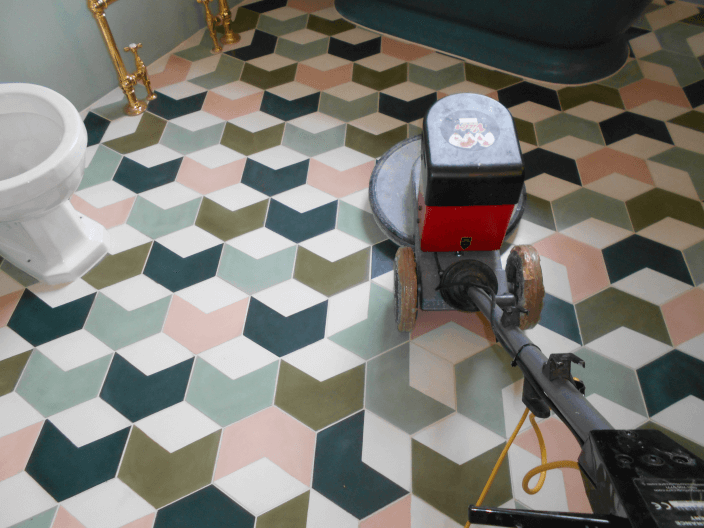

Professional Sealing process for cement encaustic tiles
Again this comes down to seeing how the tiles will behave depending on how much sealer they will take. I have found in the past that some cement tiles can be sealed many times around 7/8 coats and then I have also found that some will only take a few coats, 3/4. The way you will know if the tiles are fully saturated is if the sealer starts to remain on the surface even after buffing.
step1) fold microfibre cloth four times to form a square pad about 6 inches across. Apply impregnating tile sealer to the top of the cloth and allow it to soak through.
step2) spread the sealer over the tiles lightly using a circular motion being sure to pass over all the surface at least twice with your cloth. Keep applying sealer to the cloth as you go along.
step 3) allow sealer to soak in for about 10- 15 mins and then repeat the process. Apply 3 light coats of seal to the tiles and check to see if they are drying fully with the seal still going in. If the tiles look to be drying keep putting on more sealer. However if the tiles seem to be remaining wet then they have been saturated with tile sealer and its time to buff.
step4) For buffing ,ideally a rotary machine with a clean white pad does the trick however as a homeowner you will need to use more elbow grease and your dry microfibre cloth. Simply buff the tiles going patch by patch in a circular motion until the sealer has been worked into them and they have dried off.
